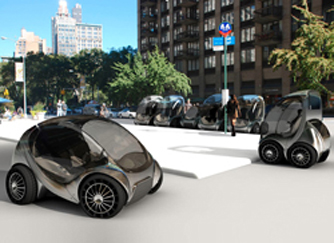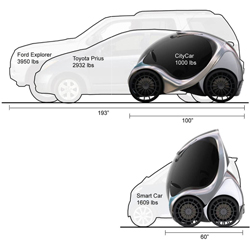Commercial Version of the MIT Media Lab CityCar Unveiled at European Union Commission Headquarters
Home > Commercial Version of the MIT Media Lab CityCar Unveiled at European Union Commission Headquarters
A full-scale version of the stackable, electric CityCar, created by researchers at the MIT Media Lab and commercialized by a consortium of automotive suppliers in the Basque region of Spain, was unveiled at the European Union Commission headquarters on January 24, 2012.
Branded "Hiriko," the vehicle incorporates all of the essential concepts of the MIT Media Lab CityCar: a folding chassis to occupy a small footprint when parked, drive-by-wire control, front entry and egress, the ability to spin on its axis, and “Robot Wheels” with integrated electric drive motor, steering motor, suspension, and braking. Since 2009, the Media Lab has collaborated with Denokinn, an industrial sponsor from Vitoria, Spain, and their partner companies to refine the design and technology of the CityCar to allow for its commercialization by industry.
INNOVATIVE ROBOT WHEELS
The CityCar project is part of larger initiative at the MIT Media Lab devoted to investigating the urban mobility systems. Conceived by a team of MIT students led by the late Professor William J. Mitchell (1944-2010), the CityCar is a two-passenger EV that is capable of folding to minimize its parking footprint.
The design utilizes a novel technology called Robot Wheels. The Robot Wheel modules are controlled electronically using by-wire systems made popular by the aerospace industry and is attached to the four corners of the foldable chassis designed by the MIT team. Each Robot Wheel can be independently controlled allowing the CityCar to execute tight maneuvers that are helpful when driving in cities such as spinning on its own axis to achieve an “O-turn.” The removal of traditional drivetrain elements like gasoline engine, transmissions, and gearboxes allows for an unencumbered chassis thus freeing up space for folding linkages. When folded, three CityCars can fit into one traditional parking space, therefore making parking more efficient in dense crowded cities. The CityCar has a range of over 100km on one charge and is capable of being rapidly charged using the latest lithium-ion battery technologies developed by industry including spinout companies from MIT.
 Mobility-on-Demand systems consisting of lightweight electric vehicles designed by the MIT Media Lab's Smart Cities research group. |
 The CityCar compared to traditional automobiles. |
Major coverage includes:
- CNet: Electric car that folds itself launches in Spain
- The New York Times: MIT CityCar, Renamed Hiriko, Is Headed to Production
- ABC News: "City Car: Hiriko Electric Fold-Up Car for Crowded Cities"
- Fast Company: Car Sharing with Crazy Folding Cars Is Coming to Europe
- The Telegraph (UK): Folding car moves closer to reality
- The Wall Street Journal: Brussels Launch for Spanish Folding Electric Car
MOBILITY-ON-DEMAND
Professor Mitchell's Smart Cities research group at the MIT Media Lab (2003-2010) designed the CityCar to take on the biggest issues facing cities today–that of congestion, inefficient energy and land-use, air and noise pollution, and carbon emissions leading to global warming. The team also created a new model of mobility that would utilize the CityCar and other lightweight EVs in a shared-use scheme. By deploying CityCars at charging points distributed throughout a metropolitan area the MIT team envisioned a new network of vehicles that would allow any user of the system to simply walk-up, swipe an access card, pick-up a vehicle, and drive to any other charging point. Called Mobility-on-Demand, this strategy would provide high levels of convenience and flexibility found in shared systems like bike sharing programs, available in much of Europe and now in North America.
Mobility-on-Demand systems also addresses what transportation planners call the "First Mile, Last Mile" problem of mass transit systems, by providing mobility near or at a user’s origin and final destination by creating a intermodal network that is complementary and synergistic to transit systems. In addition to the CityCar, the Smart Cities team also designed a folding electric motor scooter called the RoboScooter, and an electric assist bicycle called the GreenWheel. The GreenWheel integrates Lithium-ion batteries with electric motors into a modular hub unit that could easily be retrofitted into any standard bicycle. Together with the CityCar, the RoboScooter and GreenWheel would create a Mobility-on-Demand ecosystem of lightweight and low-energy EVs, where users can select the appropriate vehicle for each trip segment.
The research on urban mobility conducted by the Smart Cities group resulted in the publication of the book Reinventing the Automobile: Personal Urban Mobility for the 21st Century, published by MIT Press. Professor Mitchell wrote this book along with two top research executives from General Motors (Chris Borroni-Bird and Lawrence Burns).
THE DESIGN TEAM
A key ingredient for Smart Cities in developing these concepts was the use of anti-disciplinary research teams, a tradition formed at the Media Lab. The design team consisted of architects, mechanical engineers, electrical engineers, computer scientists, urban planners, operations researchers, neurologists, sociologists, economists, and many other fields. Ryan Chin led the graduate student team, and the designer of the CityCar was William Lark, Jr., both PhD students under Mitchell. The current team also included master’s students Nicholas Pennycooke, Praveen Subramani, and Chih-Chao Chuang. Other graduate students who worked on the CityCar project include:
Wayne Higgins
Mitchell Joachim
Axel Kilian
Patrik Künzler
Philip Liang
Michael Chia-Liang Lin
Neri Oxman
Dimitris Papanikolaou
Arthur Petron
Raul-David “Retro” Poblano
Somnath Ray
Peter Schmitt
Susanne Seitinger
Andres Sevtsuk
Franco Vairani
During the development of the CityCar concepts, MIT researchers worked closely with General Motors, a sponsor of the Media Lab until 2008. Denokinn, a Basque based economic incubator and Media Lab sponsor, acquired non-exclusive intellectual property rights to the design and technology of the CityCar and provided the Media Lab with additional research funding in 2010 to further its development.
With the death of Professor Mitchell in 2010, Kent Larson assumed the leadership role of the MIT CityCar project, which has now been incorporated into Larson’s Changing Places research group at the MIT Media Lab.
A NEW ECOSYSTEM FOR SUSTAINABLE CITIES
A related project called the CityHome examines the potential of highly personalized, responsive housing with transformable interiors so that small apartments function as if far larger. The combination of the CityHome and CityCar project are building blocks to a larger ecosystem approach towards making new cities more livable and sustainable. Researchers of the Changing Places Group are continuing to develop new vehicles, including a 3-wheel “persuasive electric vehicle,” with the goal of expanding the demographic profile of bike-lane users, as well as encouraging exercise and highly efficient mobility. In addition, the group is currently exploring how new concepts for urban housing, mobility-on-demand, and energy systems can be applied to cities in China, as well as smaller communities in the area devastated by 2011 tsunami in the Miyagi Prefecture of Japan.
CONTACT
Alexandra Kahn
MIT Media Lab
akahn@media.mit.edu